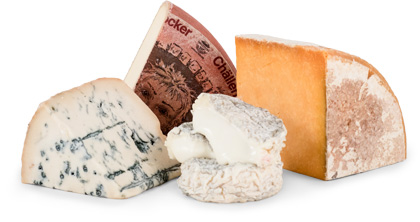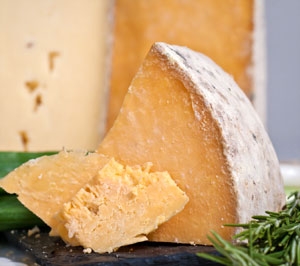Like the cheese most associated with Italy, Mozzarella, Provolone is pasta filata—an Italian term meaning “spun paste”. It refers to a technique in the manufacture of a family of Italian cheeses which we know in English as stretched-curd or pulled-curd or plastic-curd cheeses. Pasta filata cheese-making begins in the normal way. The milk is warmed and curdled and allowed to rest for an hour. Then the curds are cut into small pieces and the whey drained off. The curds then rest for several hours.
Then follows the filatura. The curds are steeped for some hours in a bath of very hot whey or water. When they begin to float most of the liquid is removed and the curd is then mixed and kneaded until the desired soft, elastic, stringy texture is obtained. The mass of curd is divided and shaped into individual cheeses. In the case of mozzarella the process is now essentially complete, but for other formaggi a pasta filata, such as Provolone, aging is required. There are two kinds of Provolone: Dolce (soft) Provolone is a young, semisoft and smooth table cheese that has typically been aged for two to three months. It's mild in flavor and smoothly velvety on the tongue. Then there is what you are about to taste—a Piccante (piquant) Provolone which can be curdled using the rennet (an enzyme used in cheese making) from a goat, lamb or calf. These rennets contribute to Piccante’s stronger flavor as does the aging process. Typically, Piccante is aged for six to twelve months, though we've known a few Italian Provolones that have been aged as long as two years.
Italian-style Provolone can be made with buffalo or cows' milk, or a mixture of the two, either of which may or may not be pasteurized. Sometimes it's lightly smoked using the branches of apple wood. Clearly, there's plenty of room for variation in the ingredients and the process of making this cheese, which is why this is one that definitely bears the mark of each individual artisan. Basically, if you take Mozzarella, hand-rub the surface with brine, bind it with rope, and hang it up in a room with the proper temperature and humidity, in time it will turn into an entirely different cheese—something very close to Provolone.
But here's how they do it in Italy. After using his unique combination of rennets to coagulate the milk, the cheesemaker cuts the newly formed curd into leaf-like slices, which are first scaled and then kneaded like dough. He works the dough until it spins and becomes elastic, and then it is pressed and molded to prepare it for aging. Each one of these fine Italian cheeses is individually hand shaped by an artisan cheesemaker. He has the delicate task of molding the cheese in such a way as to avoid formation of air bubbles or liquid in the paste, thereby achieving a smooth and uniform surface. Next the cheeses are immersed in a salt bath, and the length of time may vary. When they are removed from the brine they are washed with cold water, wrapped and secured in rope. Only then are they ready to be aged, or smoked and then aged. As they are suspended from the rope and slowly cured in the aging chamber, they become clearly recognized as Provolone. Provolone was the traditional cheese of Southern Italy. By the end of the nineteenth century, production had already spread to the Po Valley and the area between Brescia and Cremona in particular. Its name derives from the Neapolitan words "prova" or "provola," which mean globe shaped. Provolones are created in a variety of globe-like shapes, in a range of sizes from half pound melons to torpedo shapes weighing two hundred pounds.
Your authentic Italian Provolone is a grating cheese, full-bodied and buttery with a slight snap. Aged Italian Provolones are much more flavorful than standard issue sandwich provolone. Made into huge "salamis" and then aged for over a year, this succulent, sharp, buttery flavor would be the star of an antipasto plate. If you've only tried the soft, supermarket "deli" version of Provolone, this cheese should be a revelation. Serve it with Italian olives and thin slices of Prosciutto di Parma, and your friends will discover a whole new Provolone persona—Provolone as they eat it in Italy! Grate it over pizzas and pastas—or anything that calls for a cheese topping (which is just about everything if you ask us!) It melts best when shredded first. For a scrumptious treat, try it with some red grapes, pears, figs, tomatoes, roasted red peppers, olives or hearty breads drizzled with olive oil. A favorite of ours is provolone melted over fresh bruschetta. Delicious!

Experience International Variety
You might receive a Gaperon, originating in France during the 14th Century, an
authentic Lancashire by Ruth Kirkham, and an Italian Taleggio matured in the
caves of Valsassina…all in one shipment!


